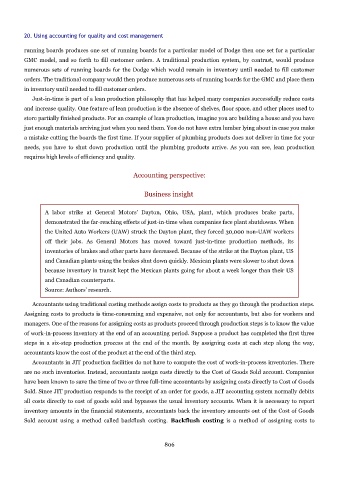Page 805 - Accounting Principles (A Business Perspective)
P. 805
20. Using accounting for quality and cost management
running boards produces one set of running boards for a particular model of Dodge then one set for a particular
GMC model, and so forth to fill customer orders. A traditional production system, by contrast, would produce
numerous sets of running boards for the Dodge which would remain in inventory until needed to fill customer
orders. The traditional company would then produce numerous sets of running boards for the GMC and place them
in inventory until needed to fill customer orders.
Just-in-time is part of a lean production philosophy that has helped many companies successfully reduce costs
and increase quality. One feature of lean production is the absence of shelves, floor space, and other places used to
store partially finished products. For an example of lean production, imagine you are building a house and you have
just enough materials arriving just when you need them. You do not have extra lumber lying about in case you make
a mistake cutting the boards the first time. If your supplier of plumbing products does not deliver in time for your
needs, you have to shut down production until the plumbing products arrive. As you can see, lean production
requires high levels of efficiency and quality.
Accounting perspective:
Business insight
A labor strike at General Motors' Dayton, Ohio, USA, plant, which produces brake parts,
demonstrated the far-reaching effects of just-in-time when companies face plant shutdowns. When
the United Auto Workers (UAW) struck the Dayton plant, they forced 30,000 non-UAW workers
off their jobs. As General Motors has moved toward just-in-time production methods, its
inventories of brakes and other parts have decreased. Because of the strike at the Dayton plant, US
and Canadian plants using the brakes shut down quickly. Mexican plants were slower to shut down
because inventory in transit kept the Mexican plants going for about a week longer than their US
and Canadian counterparts.
Source: Authors' research.
Accountants using traditional costing methods assign costs to products as they go through the production steps.
Assigning costs to products is time-consuming and expensive, not only for accountants, but also for workers and
managers. One of the reasons for assigning costs as products proceed through production steps is to know the value
of work-in-process inventory at the end of an accounting period. Suppose a product has completed the first three
steps in a six-step production process at the end of the month. By assigning costs at each step along the way,
accountants know the cost of the product at the end of the third step.
Accountants in JIT production facilities do not have to compute the cost of work-in-process inventories. There
are no such inventories. Instead, accountants assign costs directly to the Cost of Goods Sold account. Companies
have been known to save the time of two or three full-time accountants by assigning costs directly to Cost of Goods
Sold. Since JIT production responds to the receipt of an order for goods, a JIT accounting system normally debits
all costs directly to cost of goods sold and bypasses the usual inventory accounts. When it is necessary to report
inventory amounts in the financial statements, accountants back the inventory amounts out of the Cost of Goods
Sold account using a method called backflush costing. Backflush costing is a method of assigning costs to
806

